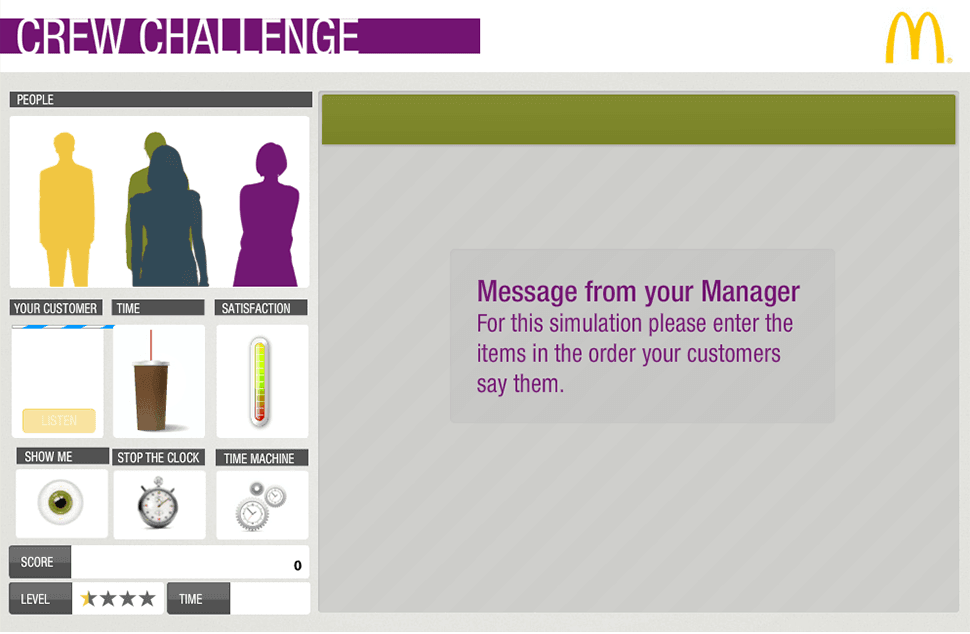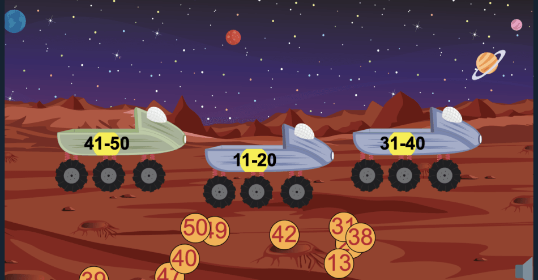What do you need more as a learning manager? Creating functional content and delivering it on a basic learning platform? Or engaging your learners with their training and increasing their learning performance? If you would like to create game-based learning, let me show you the whole picture. I'm going to tell you not just game-based learning strategy, and share with you examples of companies who have already implemented serious games in their blended learning training courses. I will also try to argue that computer video games really help to boost your training to a new level and give results which you are struggling to reach using traditional approaches.
How Belitsoft Can Help
Our experience in eLearning includes game-based training projects and much more. Here’s how we can assist you:
- Serious games development. All the stages from setting the goals and game design to post-launch support.
- Custom learning platform development. If you want your serious game to be a part of a larger project, let us know - custom systems like that are our bread and butter.
- Consulting. We have cut our teeth on custom eLearning software development, so if you need some advice on game-based learning or other kinds of electronic training, feel free to drop us a line.
Serious Learning Games Engage
Engaging learners is the #1 challenge faced by L&D professionals. Better engagement means more motivated employees, which then results in substantially higher productivity (202% better performance), better retention, fewer accidents, better employees’ health, and 21% higher profitability (Gallup).
Why is it so difficult to engage employees in the required learning courses?
- Employees aren't engaged with training content, because they aren't engaged at their work in general. 53% of employees are not engaged at work and 13% are actively disengaged (Gallup, 2018). The resistance of organizations to change (including the adoption of the new technologies, and the younger workers’ unique expectations) are among the common reasons.
- The learning process becomes harder for objective reasons (the limited brain capacity) in today's world where the volume of data is exploding. The information overload damages interest and motivation, different surveys show. The cognitive load forces the learner to miss information, resulting in incomplete training.
- Traditional engagement techniques such as “a gift card or the privilege of leaving early one day” (the carrot) or “complete it to avoid reprimand from the boss” (the stick) will not inspire a deeper learning experience.
How does game-based learning address this challenge?
- Based on sound instructional design, the learning game approach increases engagement (stimulates interest) and boosts motivation to learn the topic.
- Learners are engaged in game-based learning significantly longer than in nongame-based learning. Effective serious games form a positive mood to encourage players to continue the play.
THE NEUROSCIENCE OF LEARNING GAMES
- Playing a game stimulates the hippocampus - an area in the brain, where new memories are made, which facilitates the storage and recall of new information.
- Dopamine, or the “feel-good hormone”, is released whenever we are rewarded for a specific action. Learning games focus on giving learners instantaneous feedback which might not otherwise be available. By giving virtual rewards for achieving learning goals, learners begin to associate the learning with positive emotions, prompting them to try to repeat it (ie, seek out more learning).
- One of the key components of a compelling game is a good story. People tend to remember stories better than lists of unconnected facts. This isn’t just a matter of preference; it’s a physiological imperative. When we are engaged in a strong narrative, the brain releases oxytocin – a chemical that generates feelings of trust and empathy. As a result, when the brain receives information presented as a story, it recognizes it as being more valid.
- Serotonin release is also triggered by remembering past successes. In most game-based systems, users earn badges for completing tasks and these are usually housed in a prominent badge cabinet or an achievements area. On a gamified learning platform, learners get a serotonin rush on demand whenever they look at rewards they have earned.
- Endorphins are the body’s natural painkiller but they can also lower stress and anxiety levels, and even create a sense of euphoria. Combined with other neurotransmitters, this helps create an ideal environment for focused learning.
- In a study conducted by BBC’s Horizon, a test group of older subjects played a popular racing game for 15 hours over 5 weeks. When they were evaluated after that period, their memory and attention span scores had improved by around 30%.
- Cortisol is known as the stress hormone and it controls the body’s reaction to stressful situations. When it comes to learning, high levels of cortisol force the brain into survival mode, distracting from the learning in order to deal with the stress. By adding game-like elements to the journey, this effect can be mitigated. Results of a Texas A&M International University study showed that “games reduce depression and hostile feelings in players through mood management.”
EXAMPLES
This is how companies already use game-based learning for their benefit.
HEALTHCARE
Pulse!!
Pulse!! is a virtual trainer that helps medical students and residents practice treatment of the emergency patients.
Pulse!! allows a player to run tests, monitor vitals, and give orders to nurses - everything to save the patient. The injured person himself, by the way, can respond to treatment (or lack thereof) to provide real-time feedback. The player wins if they diagnose and treat the patient in time.
This serious game can be used to train both civilian and military medical personnel, as the possible scenarios include combat wounds or terrorist attacks.
V-DIT
The Virtual Dental Implant Trainer is, as the name suggests, a VR simulator that trains students to conduct a dental implantation procedure.
Each scenario includes an interview with the patient to determine whether they even need an implant and which kind. The characters (both the patients and the player) are fully voiced to improve immersion. Once it is done, the player can practice an actual procedure in a safe environment.
Sales
Vision
Vision is a training simulator for eye care specialists. It includes a detailed discussion with a fully voiced customer character and a branching dialogue tree that would do any RPG proud.
After the player talks to the customer, recommends the appropriate eyeglasses, and (hopefully) makes a sale, they are evaluated based on their skills in discovering the customer needs, sales, and product knowledge. In addition, they can receive badges as rewards for excelling in certain areas.
Vision is used by Essilor, a company that sells eyeglass lenses.
Mercer City
Mercer City is a sales training game used by Mercer - a major consulting firm. It is intended to be a part of a blended learning environment alongside a human coach.
The game allows players to practice communicating with the customers, allocating resources, discussing the consulting process, and other issues. The users are then judged based on their performance.
Mercer City includes many realistic situations to ensure that the knowledge the users gain will be helpful in practice.
Crew Challenge
This game was developed for McDonald’s to help the new hires get acquainted with the POS device quickly and learn the sales process used in the franchise.

Crew Challenge simulates working at the till with customers lining up and behaving like real people. The player must keep them happy and get their orders correctly. Moreover, this is all done in real-time to achieve better immersion and make training more efficient.
Unlike many other examples, this game released the data about its effectiveness. The average time for till service decreased by 7.9 seconds and the average sale has grown by 15 pence. Seems small, but it adds up to 18.000 pounds per restaurant.
Other
vBank
This game is aimed at the auditors and helps them fight fraud.
The vBank gameplay includes both interviewing people and studying documents. As the auditor follows the money trails they are able to locate unlawful activities (if there are any). This game is being used by the Federal Deposit Insurance Corporation (FDIC).
How to Introduce Game-Based Learning
1. Set Goals
You don’t know whether you have been successful or not if you haven’t defined success. The best way to do so is to set the right goals.
Take a look at the SMART framework:
- Specific. For example, “Increase the speed at which the new workers operate the “Coffeemaster-2000” machine”.
- Measurable. “Increase the speed at which the new workers operate the “Coffeemaster-2000” machine by 50%”.
- Achievable/Attainable. “Increase the speed at which the new workers operate the “Coffeemaster-2000” machine by 20%” because it is impossible for a human to move that much faster.
- Realistic/Relevant. “Increase the speed at which the new workers operate the “Coffeemaster-2000” machine by 20%” seems relevant for a coffee shop chain.
- Timeframe. “Increase the speed at which the new workers operate the “Coffeemaster-2000” machine by 20% in two months.”
Once your goal is set you will both have a point B to go to and a reliable benchmark to measure your efficiency.
2. Select the Game
Depending on the skills and/or knowledge you want to impart on your learners, different games will have different levels of efficiency. For example, a race where the player increases their car’s speed by answering the questions correctly might help employees remember the ingredients better, but a VR simulator will be better at teaching people how to operate a machine.
This is also a time to evaluate your own competencies. Serious games are a serious business and take time and effort to design and develop. If this is not your forte, consider hiring a contractor or at least bringing a consultant on board.
3. Design and Develop
Now that you know what you want to achieve and how, it is time to bring your idea to life. Whether you are going to do it yourself or through a contractor is entirely up to you.
At the design stage, make sure the game rewards the behavior you want to encourage. Otherwise, it could be fun but counterproductive.
4. Test
Before you launch the game, make sure to test it. Gather a group of potential learners and have them play just as they would in real life. After that measure their skills and knowledge and gather their feedback.
This phase is called “User Acceptance Testing” and can give you a treasure trove of information regarding the effectiveness of your game and the users’ attitude.
5. Release
Now you can be sure that you are getting closer to your goals, so it’s time to launch the game and enjoy the results.
Rate this article
Recommended posts
Portfolio
Our Clients' Feedback






















.jpg)
.jpg)
.jpg)














Belitsoft has been the driving force behind several of our software development projects within the last few years. This company demonstrates high professionalism in their work approach. They have continuously proved to be ready to go the extra mile. We are very happy with Belitsoft, and in a position to strongly recommend them for software development and support as a most reliable and fully transparent partner focused on long term business relationships.
Global Head of Commercial Development L&D at Technicolor